 Image search results - "grave" Image search results - "grave" |

Marker and side road to Lord Gamo (Gamoh) Ujisato's gravesite. Near Aizu-Wakamatsu City Hall. Gamo Ujisato (1556-1595) was a feudal lord from Hino, Shiga Pref. He built Tsurugajo Castle and named the town Wakamatsu, after a place in his hometown.
|
|

Entrance to Iimoriyama Hill, site of the Byakkotai "White Tiger" Battalion gravesite. In 1868, a unit of teenage warriors called Byakkotai (White Tiger Battalion) fought against the Emperor-backed Imperial forces encroaching their domain of Aizu
|
|

Ujisato was married to Oda Nobunaga's second daughter Fuyuhime. He died at age 40. One theory says that he was poisoned by Toyotomi Hideyoshi. Entrance to Lord Gamo Ujisato's gravesite within Kotokuji temple in Aizu-Wakamatsu, Fukushima..
|
|

The Byakkotai were outnumbered and forced to retreat. Twenty of them escaped to Iimoriyama Hill where they saw what looked liked a burning Tsurugajo Castle. Photo: Pay a small fee to take the escalator up the hill. Or climb up the steps for free.
|
|

Entrance doors to Lord Gamo Ujisato's gravesite within Kotokuji temple which is a Zen temple of the Rinzai Sect.
|
|

In despair, the boys decided to kill themselves rather than die in the hands of the enemy. Photo: Escalator to go up Iimoriyama Hill.
|
|

Family crest on door. (Not the Gamo crest.)
|
|

Escalator to go up Iimoriyama Hill. Their tombstones are on this hill near where they killed themselves. Their story has become legend.
|
|

Grounds of Lord Gamo Ujisato's gravesite within Kotokuji temple. Since Ujisato was a Christian lord, it is ironic that he be buried in a Buddhist temple in Kyoto and Aizu-Wakamatsu.
|
|

Byakkotai Gravesite. It is on a flat area which also has several other Byakkotai monuments including those from other countries.
|
|
|

Approach to the Byakkotai gravesite.
|
|

Poem monument reads 限りあれば吹かねど花は散るものを心短き春の山風
|
|
|

Path to Lord Gamo Ujisato's gravesite
|
|

Graves of the 19 teenage Byakkotai warriors who killed themselves with their own swords.
|
|

Lord Gamo Ujisato's grave.
|
|

Byakkotai Graves
|
|

Lord Gamo Ujisato's grave. This is a secondary grave, where his hair is buried. His main grave is at a temple in Kyoto where he died at age 40.
|
|

Byakkotai Graves
|
|

Main entrance to Aoyama Cemetery during cherry blossom season in early April. Gaienmae Station (Ginza/Hanzomon Line) and Nogizaka Station (Chiyoda Line) are the closest subway stations.
|
|
|

Byakkotai gravestones. Each one shows the name, age, and method of death called "jijin" (died with one's own sword 自刃).
|
|

The tombstone has five segments each with a kanji character. 五輪塔
|
|
|
|

Aoyama Cemetery office near the main entrance where you can obtain a map of the cemetery and ask where particular people are buried. The maps they provide do not show where the most famous people are (such as prime ministers).
|
|

Main thoroughfare, lined with cherry trees, cuts through the middle of the cemetery where cars whiz by. Quite irritating.
|
|

Explanation of the kanji characters on the tombstone. From top to bottom, the characters are for "Sky, wind, fire, water, and earth."
|
|

This has become a national shrine, almost as important as Sengakuji where the 47 masterless samurai are buried.
|
|

Cherry blossom tunnel at Aoyama Cemetery.
|
|

Portrait of Lord Gamo Ujisato
|
|
|
|
|

Aoyama Cemetery is one of Tokyo's noted spots for cherry blossoms. However, having hanami picnics is not allowed.
|
|

Cherry blossoms are so fleeting. They last for only a short time, like life itself. And so cherry blossoms are often found at cemetaries in Japan.
|
|
|

These trees stood out.
|
|
|
|

Cherry blossoms and graves.
|
|
|
|
|

Aoyama Cemetery map. Quite complicated system to find grave plots.
|
|

Kotokuji temple
|
|
|
|

Signs tell you where you are. Quite bewildering mapping system.
|
|

On the right side are more gravestones. These are 31 Byakkotai members who died in battle. 戦死
|
|

Aoyama Cemetery has over 123,000 graves occupying 125,000 square meters within the cemetery land area of 263,564 sq. meters.
|
|

Tombs of those Byakkotai who died in action.
|
|

This is the Foreigner's Cemetery where many foreigners who helped to modernize Japan are buried.
|
|

Tombs of those Byakkotai who died in action.
|
|

A monument erected in March 2007 by Tokyo Governor Ishihara Shintaro in appreciation of the foreigners who helped build Japan.
|
|

Their names, age, and "senshi" 戦死 (died in battle) are engraved on the stones.
|
|

List of foreigners buried in this Foreigner's Cemetery. Note that there also other foreigners buried in other parts of Aoyama Cemetery.
|
|
|

Foreigner's Cemetery 外国人墓地
|
|

Monument for teenage samurai who died in battle.
|
|

Foreigner's Cemetery 外国人墓地
|
|

Names of Byakkotai members, all 14 to 17 years old.
|
|

Grave of Edoardo Chiossone (1833-1898), an Italian who introduced printing technology (for money and stamps) to Japan. He loved Japan and amassed a huge collection of Japanese art, especially woodblock prints. The collection is donated to a Genova museum.
|
|

On the left of the gravestones, there is a monument for a poem composed by Lord Matsudaira Katamori, the last Aizu lord and whom the Byakkotai died for. 幾人の 涙は石にそそぐとも その名は世々に 朽じとぞ思う幾人の 涙は石にそそぐとも その名は世々に 朽じとぞ思う
Ikutari no namida wa ishi ni sosogu tomo sono na wa yoyo ni kuji to zo omou
"No matter how many people pour their tears on these stones, these names will never fade from the world."
|
|

Gravestone of Edoardo Chiossone
|
|

A short walk away is the grave of Iinuma Sadakichi, the only Byakkotai survivor who had slit himself, but was rescued by a villager passing by when everyone else had killed themselves.
|
|

Grave of Joseph Heco who was born Japanese (as Hamada Hikozo) but naturalized as a US citizen.
|
|

Grave of Iinuma Sadakichi, the only Byakkotai warrior who survived and told the story of this valiant teenage group.
|
|

Grave of Joseph Heco
|
|

Grave of Iinuma Sadakichi (Sadao) (1854-1931). His grave was built here in 1957 for the 90th anniversary of the Byakkotai's demise. 飯沼貞吉
|
|

Grave of the family of Robert Walker Irwin (1844-1925), Hawaiian Minister to Japan. (Iron gate has since been removed.)
|
|

Graves of the family of Robert Walker Irwin (1844-1925), Hawaiian Minister to Japan.
|
|

Grave of Robert Walker Irwin (1844-1925), Hawaiian Minister to Japan and his Japanese wife Iki. Eldest child Bella Irwin is also buried here.
|
|

Gravestone of Robert Walker Irwin (1844-1925), Hawaiian Minister to Japan and his Japanese wife Iki.
|
|

Grave of Robert Walker Irwin Jr. (Robert Walker Irwin's first son) and his first wife Fusako.
|
|

Grave of Richard Irwin (Robert Walker Irwin's second son) and his son Takeo and daughter Yukiko Irwin.
|
|

Grave of Mary Irwin (Robert Walker Irwin's second daughter).
|
|

Grave of Tsuneko Irwin second wife of Robert Walker Irwin Jr. and her son John.
|
|

Grave of Tsuneko Irwin second wife of Robert Walker Irwin Jr. and her son John.
|
|

This stone monument gives the biography of Robert Walker. His birthdate, descendant of Benjamin Franklin, his move to Japan, companies he worked for in Japan including Mitsui Bussan, supervision of the immigration to Hawaii,founding of the Taiwan Sugar Co., and the decorations he received from the Japanese government. Died in 1925 at age 81.
ロベルト・ウォルカー・アルウインは米国費府
の住民にして西暦千八百四十四年一月七日
に生まれベンジャミン・フランクリンの後裔也
慶應二年十一月来朝し海外貿易又は日本海
運の開発誘導に貢献するところ頗る多く三
井物産会社其他に勤務し後ち日本駐劄布哇
国公使に就任して日本移民の布哇渡航を企
画成功す蓋し之れ日本移民海外発展の基と
なれるものにして実に日本移民事業の開祖
たり明治三十三年台湾製糖株式会社の創立
発起人となり日本糖業の為めに尽くすとこ
ろ又尠なからす勲一等に叙せられ瑞鳳章を
賜ひ後ち又旭日大綬章を賜ふ大正十四年一
月五日永眠す行年八十一才也
|
|

Monument dedicated to Bella, built by the Irwin Gakuen (formerly Gyokusei Gakuen) alumni association (Gyokusei-kai) for the school's 70th anniversary in Nov. 1985.The bottom has a bio of Bella.
|
|

This originally was for grave visitors to leave their business cards, but it does not work. (As of this writing, there is no receptacle to collect the cards.)
|
|

About Iinuma Sadakichi (later changed his first name to Sadao)
|
|

Graves of Robert Walker Irwin (rear, on the right) and his family. (Old photos of the graves.)
|
|

Slope where they committed seppuku (hara-kiri). 自刃の地
|
|

Site where they committed seppuku (hara-kiri). 自刃の地
|
|
|

Grave of loyal dog Hachiko and his master, Professor Ueno.
|
|
|

Grave of Yoshida Shigeru, Japan's first postwar prime minister.
|
|
|

Grave of Yoshida Shigeru 吉田茂の墓
|
|

An unkept grave.
|
|
|
|
|
|

A recent addition is this statue of a teenage samurai looking at Wakamatsu Castle.
|
|

Statue of a teenage samurai looking at Wakamatsu Castle.
|
|
|

Statue faces Tsuruga-jo Castle which can be seen in the distance.
|
|

Arrow points to Tsuruga-jo Castle.
|
|
|

Byakko Kannon statue
|
|
|
|
|

Monument from Rome, Italy, given in 1928 by Mussolini. The column is from the ruins of a palace in Pompeii.
|
|

Monument message in Italian. After WWII, the US Occupation authorities wanted this monument removed. But all they did was remove the engraved message (later restored).
|
|

About the monument from Rome.
|
|

Monument from a German, Hasso von Etzdorf (1900 - 1989).
|
|

Another monument
|
|

Opened in 1956, the Byakkotai Memorial Museum has numerous artifacts related to the Byakkotai as well as the Shinsengumi. Photography inside is not allowed. Admission 400 yen.
|
|

Byakkotai statue outside the Byakkotai Memorial Museum
|
|
|

Cemetary
|
|
|
|
|

The temple itself looks so modern and ordinary that it does not look like a temple.
|
|

Pet memorial, Eko-in
|
|

Pet memorial, Eko-in temple.
|
|
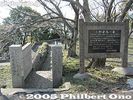
Grave of Ueno Hikoma
|
|
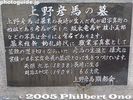
Grave of Ueno Hikoma
|
|
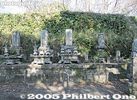
Grave of Ueno Hikoma
|
|

Grave of Ueno Hikoma
|
|

Way to the graves of Hojo Nakatoki and his men who committed suicide.
|
|

A few steps up a slope.
|
|

Memorial for Hojo Nakatoki and his men. They had lost to Ashikaga Takauji in the battle at Kyoto and were trying to escape to Kamakura, but was caught by Takauji's forces at Bamba.
|
|

Over 430 gravestones. Hojo Nakatoki and his men were besieged in Bamba by Southern Imperial Court forces. They fought back, but lost and slit their bellies in front of Rengeji's Hondo main hall.
|
|

The temple's third priest wrote the names and age (youngest was 14) of the known fallen warriors in a scroll. He also made these gravestones for them. Visuallly, it's very impressive edifice.
|
|

Graves of Hojo Nakatoki and his men from the Rokuhara Tandai. 北条仲時一行の墓
|
|

The gravestones have five levels. In fall, the surrounding maple leaves turn blood red.
|
|

There are more steps which lead to graves of temple priests and Saint Ikko's mausoleum.
|
|

Graves of previous temple priests.
|
|

Mausoleum of Saint Ikko Shunsho.
|
|

Small mausoleum for Saint Ikko. 一向上人の御廟
|
|
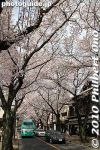
Way to Tama Cemetery. One of Tokyo's major cemeteries with the graves of celebrated figures including politicians, scholars, and novelists. Also a noted cherry blossom spot in spring.
|
|
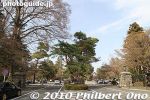
Front entrance to Tama Cemetery.
|
|
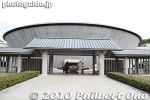
Mitama-do Hall
|
|
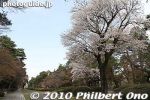
The cemetery is basically in a grid pattern.
|
|
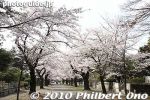
The main roads have cherry trees.
|
|
|
|
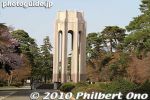
Tama Cemetery Fountain tower.
|
|
|
|

Memorial plaque in Japanese and English.
|
|
|
|
|
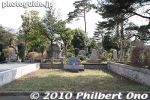
Empty grave plot.
|
|
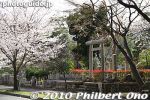
Torii gate at this gravesite.
|
|
|
|
|
|
|
|
|
|
|
|
|
|
|
|
|
|
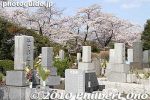
Cherry blossoms and graves at Tama Cemetery.
|
|
|
|
|
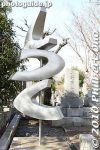
Elaborate grave sculpture.
|
|
|
|
|
|
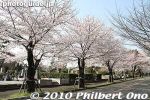
Some of the best sakura trees are on this main road.
|
|
|
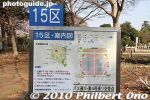
Cemetery map and sign.
|
|
|
|
|
|
|
|
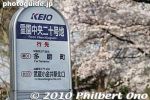
Bus stop for JR Musashi-Koganei Station.
|
|

Way to cemetery. Six Hikone Castle lords, including Ii Naosuke, have graves here. Setagaya was the domain of the Ii clan who often worked in the Tokugawa government.
|
|

Straight ahead is the grave of Lord Ii Naotaka, the 2nd lord of Hikone Castle in Shiga Prefecture.
|
|

Turn left and you see this. Ii clan graves on both sides. Lord Ii Naosuke's grave is at the very end on the left.
|
|

Lord Ii Naosuke's grave is at the very end on the left.
|
|

Grave of Lord Ii Naosuke (1815-1860), the lord of Hikone Castle in Shiga Prefecture and Chief Minister of the Tokugawa Shogun's government. Gotokuji temple, Setagaya-ku, Tokyo. 井伊直弼の墓 豪徳寺
|
|

Only Ii Naosuke's grave has a sign explaining about him.
|
|

Grave of Lord Ii Naosuke (1815-1860), the lord of Hikone Castle in Shiga Prefecture and Chief Minister of the Tokugawa Shogun's government. Gotokuji temple, Setagaya-ku, Tokyo. 井伊直弼の墓 豪徳寺
|
|

Gravestone of Ii Naosuke.
|
|

Right side of Lord Ii Naosuke's grave.
|
|

Tree of white camellias grow about Lord Ii Naosuke's grave.
|
|

Grave of Lord Ii Naosuke's wife.
|
|
|

Grave of Lord Ii Naohide (1755-1789). He served as Tairo Chief Minister in the Tokugawa government. Gotokuji temple, Setagaya, Tokyo 井伊直幸
|
|

Grave of Lord Ii Naotaka's eldest daughter who donated a lot to the temple. 井伊直孝長女
|
|
|

Grave of Lord Ii Naotaka (1590-1659), 2nd lord of Hikone, Shiga. Gotokuji temple, Setagaya, Tokyo 井伊直孝
|
|

Grave of Lord Ii Naoyoshi (1727-1754), Gotokuji temple, Setagaya, Tokyo 井伊直禔
|
|

Grave of Lord Ii Naotsune (1693-1710), Gotokuji temple, Setagaya, Tokyo 井伊直恒
|
|

Grave of Lord Ii Naonori on right.
|
|

Grave of Lord Ii Naonori (1848-1904), Gotokuji temple, Setagaya, Tokyo 井伊直憲の墓
|
|

Six Jizo
|
|
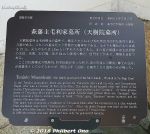
About Tenjuin Mausoleum.
|
|
|
|
|

Grave of Mori Terumoto.
|
|

The graves of Mori Terumoto and his wife.
|
|

Grave of retainer Motofusa Nagai and his loyal cat.
|
|

Sign pointing the way to wrestler Rikidozan's grave.
|
|

Rikidozan's grave, the temple's most famous grave.
|
|

Rikidozan's grave
|
|

Rikidozan's gravestone
|
|

Statue of Rikidozan who was famous for his "karate chop" during the 1950s and early '60s. This famous postwar "Japanese hero" was actually Korean.
|
|
|
|

Statue of Rikidozan (1924-1963) at his grave at Ikegami Honmonji temple, Tokyo. He was a sumo wrestler until 1950 before becoming a pro wrestler.
|
|

Behind the pagoda are many graves.
|
|

Graves near Hoto tower
|
|

About the Kyogoku Clan graves at Tokugen-in temple. It was Kyogoku Takatoyo, lord of Marugame in Shikoku, who in 1672 acquired the temple land and gathered all the Kyogoku graves scattered in the area to Tokugen-in.
|
|

Kyogoku Clan graves at Tokugen-in temple. Kyogoku Takatoyo, the 22nd Kyogoku Clan leader, renamed the temple Tokugen-in after the posthumous Buddhist name of his father Takakazu.
|
|

Layout of Kyogoku Clan graves at Tokugen-in temple. There is a lower level and an upper level of graves on a slope accessible by stairs. Although Ujinobu was the first to make it the clan's family temple, it was quite dilapidated by Takatoyo's t
|
|

Kyogoku clan graves. Grave of Kyogoku Takatsugi is on the left.
|
|

Grave of Kyogoku Takatsugi, husband of Hatsu, one of the Azai sisters.
|
|
|
|
|

Graves of the Tadotsu Clan (多度津藩), a branch of the Kyogoku who ruled in Marugame. From left to right, Kyogoku Takateru (高琢), Takakata (高賢), Takabumi (高文), Takayoshi (高慶), and Takamichi (高通).
|
|
|

Kyogoku clan graves
|
|

The first Kyogoku grave, that of Ujinobu, the founder of the Kyogoku Clan.
|
|

The first Kyogoku grave, that of Ujinobu, the founder of the Kyogoku Clan.
|
|
|

View from the upper level Kyogoku graves.
|
|
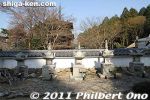
Graves of the Tadotsu Clan (多度津藩), a branch of the Kyogoku who ruled in Marugame. From left to right, Kyogoku Takateru (高琢), Takakata (高賢), Takabumi (高文), Takayoshi (高慶), and Takamichi (高通). National Historic Site
|
|
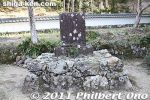
Epitaph 碑文
|
|
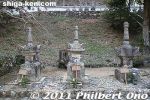
Graves of Kyogoku Takayoshi (京極 高美), Takatoo (京極 高迢), and Takamasa (京極高政). They were much less prominent.
|
|
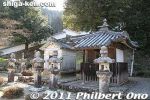
Kyogoku Takatsugi and Kyogoku Takanori's (1718-1763) grave
|
|
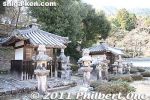
Kyogoku Takanori (1718-1763) and Kyogoku Takanaka's (1754-1811) graves.
|
|
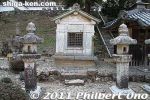
Kyogoku Takatsugu's grave.
|
|
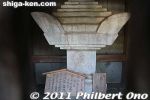
Inside Kyogoku Takatsugu's grave.
|
|
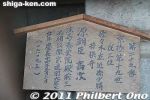
Kyogoku Takatsugu's grave.
|
|
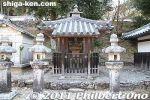
Kyogoku Takanori's (1718-1763) grave. He was the fourth lord of Marugame in Shikoku. 京極高矩
|
|
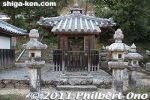
Kyogoku Takanaka's (1754-1811) grave. He was the fifth lord of Marugame in Shikoku. 京極高中
|
|
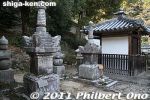
Two lesser graves for Kyogoku Tadataka (京極忠高) and Takakazu (京極高和), the eldest son of Takatsugu.
|
|
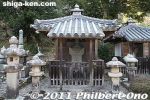
Grave of Kyogoku Takatoyo, second lord of Marugame in Shikoku. 京極高豊
|
|
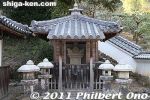
Grave of Kyogoku Takamochi, third lord of Marugame in Shikoku. 京極高或
|
|
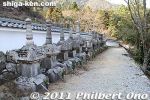
There are steps to go up the hill where there are more Kyogoku graves. These are for the older Kyogoku members, starting with the founder of the Kyogoku Clan.
|
|
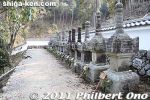
The narrow upper level has 18 gravestones, starting with the first Kyogoku Clan leader Ujinobu on the right.
|
|
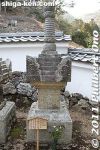
The first Kyogoku grave, that of Ujinobu, the founder of the Kyogoku Clan. 氏信
|
|

View from the hill.
|
|

Stone marker for the Kabuto-zuka Tumulus 兜塚古墳. Tokyo Prefectural Historic Place. About a 10-min. walk from Komae Station (Odakyu Line). 兜塚古墳Komae has numerous ancient tumuli, some say up to 100. However, most have been dismantled and only 13 are left. Kabuto-zuka is the city's largest tumulus, in the middle of a residential neighborhood. It is round, with a diameter of 38 meters, and height 6 meters. It is a Tokyo Prefectural Historic Place. Most other tumuli are on private property and permission is required to enter them.
|
|

It's just a small hill 6 meters high, 38 meters diameter.
|
|

Komae used to have about a hundred tumuli, but most have been destroyed. Only 13 are left. Only two are open to the public, while the others are on private property.
|
|
|
|
|
|
|

Nakae Toju's gravestone (left) in Adogawa, Takashima. 藤樹先生墓所
|
|
|
|